The Groups viewport is a great workflow streamlining tool allowing users the ability to easily control multiple items and/or channels within a scene, and also provides a number of functionalities to speed up common tasks, such as setting keyframes for complex hierarchies. In addition, many function of modo also use Groups as specialized containers, assembling together items, channels, values and settings for a variety of purposes. However, for most of these specialized functions, user will be using the specific interface options, rather than directly creating a Group and populating it with the desired settings manually. Lastly, Groups can be used to extend the functionality of 'Replicators' and the 'Light Linking' features. Note that 'Groups' used in this context should not be confused with the 'Group' Items in the Item List which are a purely organizational construct, and Shader Tree 'Groups' which define masks for surface shading as well as to organize the many Shader Tree layers.
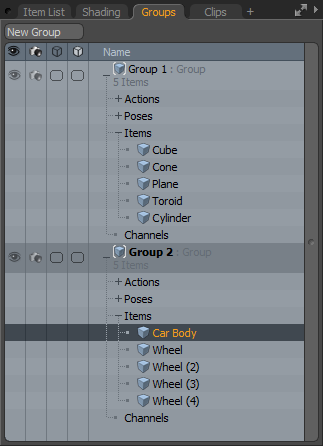 To work with groups, one will first need to create a new group using the 'New Group' button on the top of the viewport. This opens a popup dialog where the users name the Group, define the type of Group desired and set the mode for how item and/or channels are added automatically. Groups can be made up from any number of scene items, including Mesh Items, Cameras, Lights, and even Locators. Channels can also be part of a group to speed up animation workflows. When in 'Item' mode, additional items can be added to a group by drag and drop, simply select the item in the 3D viewport you wish to add and click-drag it to the group window and release the mouse button over the group you wish to add the items to. An orange highlight appears in the list to denote where the item will land when dropped. Channels can be added in the same fashion from the 'Channels' viewport.
To work with groups, one will first need to create a new group using the 'New Group' button on the top of the viewport. This opens a popup dialog where the users name the Group, define the type of Group desired and set the mode for how item and/or channels are added automatically. Groups can be made up from any number of scene items, including Mesh Items, Cameras, Lights, and even Locators. Channels can also be part of a group to speed up animation workflows. When in 'Item' mode, additional items can be added to a group by drag and drop, simply select the item in the 3D viewport you wish to add and click-drag it to the group window and release the mouse button over the group you wish to add the items to. An orange highlight appears in the list to denote where the item will land when dropped. Channels can be added in the same fashion from the 'Channels' viewport.
The viewport itself has a number of controls. The columns on the left allow the user to make changes that affect all items in the Group. The first column affects visibility for items within the group, essentially the same way the eye column toggles visibility in the 'Item List'. The second column toggles render visibility; whether or not items appear in rendered output. Note that both these settings can be overridden by the same settings on the individual item's Properties forms. For example, if a user has a group containing 20 items, of which 5 were set to 'Yes' for visibility in individual items properties, then toggling the groups visibility would only toggle 15, as the other 5 items settings would override the group settings. Setting the 5 individual items back to 'Default' would return the items back to following the group settings.
The third column when clicked will present a color picker that will change the wireframe color for all items within the group (only visible when the 3D viewport is set to 'Wireframe') and the fourth column will change the solid display fill color for all items in the group (visible in the 'Solid', 'Shaded', 'Texture' and 'Texture Shaded' display modes). Changing the display colors of items can be an easy way to visually tell which items are members of which group in scenes with many items. Individually, item settings can be adjusted within the 'Display' viewport when selected.
Preceding the group names and item and channel lists are little +/- toggles that unfold/fold list visibility. When the lists are unfolded, individual items can be selected and their respective properties or channel settings can be viewed in the appropriate viewport.

Pressing the 'New Group' button near the top of the viewport opens the 'New Group' creation dialog that allows users to define the initial Group. Though a variety of Groups can be generated, users will mostly use the specific UI controls located elsewhere in modo for generating specialized Groups.
Name: This text input field allows users to define the desired name of the Group when generated.
Type: The 'Type' option allows users to determine the type of Group generated.
Standard- This type is for general groupings of items, and also for collecting together items for Replicators or Light Linking.
Assembly- Assemblies are collections of Nodes within the Schematic Viewport used to organize and compartmentalize special functions. Assemblies will generally be created in the Schematic viewport.
Actor- Actors are generally collections of the multiple elements that make up a single character in a scene, but they can be collections of any type of item and will aid in animation keyframing, and allow some specific function related to the timeline. Actors are most often created in the Animation layout interface using its specific controls.
Render Passes- Render Passes collect channel settings together that allow users to vary the values in a single pass. The resulting passes are rendered in succession when using the Render Passes option. The controls for automatically crating passes are found in the Render layout.
Key Sets- Key Sets collect together various channels so keyframes can be assigned simultaneously. The controls for creating Key Sets are found in the Animation layout.
Channel Sets- Channel Sets are collections of channels that can be viewed and modified directly in the 3D viewport as an overlay. These are defined in the Animation layout as well.
Preset- Preset Groups are created when working with Presets, collecting the items into a container where their associated settings can be stored. Users will define Presets using the various Presets options found throughout modo.
Shader- When assigning Item Shaders to multiple items, a Shader Group is generated to store the associated values.
Mode: The 'Mode' option determines how Items or Channels are initially added to the generated Group. Additional selections can be added and removed at any time.
Empty- Generated a new Group with no Items or Channels.
From Selected Items- Generates a Group that included any items that are currently selected in the scene.
From Selected Channels- Generates a Group that included any channels that are currently selected in the scene.
From Item Edits- Generates a Group that includes any Items that have been edited form their default Scene action state.
From Channel Edits-Generates a Group that includes an Channels that have been edited from their default Scene action state
Channels in Groups--
Groups can contain any number of individual channels from any combination of items in the scene. These Individual channels can also be members of as many different groups the user wishes. If the visibility of a group containing channels is turned off, then those channels will be hidden in the various channel lists, i.e. the main Channel List viewport, Graph Editor and Channel Links viewport, though Properties are not affected by this setting. If a Group containing channels is locked, then the channels cannot be edited anywhere, including the Channel list, Properties viewport or interactively in a 3D viewport with the transform tools.
Group Parenting--
Groups can be parented together, similar to 3D items, just drag a child group and drop onto a parent item, working the same way parenting is performed in the Item List. Instead of inheriting transforms from their parents though, they inherit the group settings from their parent groups. Groups do not need to have any member items or channels either. They can be used as organizational tools. An example would be multiple groups each containing many items. If parented to an empty group and the visibility is switched off on that group, then all the child groups and hence their member items will be hidden in the 3D views.
Group visibility and render channels can also override in the same way as their counterparts on mesh items. So in the above example setting one of the child group's visibility channel to 'Yes' will override the parent setting making all members of the group visible. Conversely if the parent group visibility is set to show member items, then setting a child's visibility channel to 'No' will override that and hide its members. All other children of the parent group will still get their settings from the parent group. This also applies to the group's 'Render', 'Selection' and 'Locking' settings available by the RMB context menu.
Group Drawing Settings--
The 'Wireframe' and 'Fill' columns of the 'Groups' viewport allow easy access to basic display settings, however groups also support the full custom drawing settings available for 3D items. If you look in the 'Display' viewport with a group selected you'll see an “Add Group Draw Options†button which when clicked will display the custom drawing channels used for 3D items (if you've already set a wire or fill color for the group the custom drawing channels will already be available). The difference with setting these channels on a group as opposed to individual items is that the group settings will apply themselves to all items within the group.
Group custom drawing is layered from parent groups to child groups, so settings on parent groups will override any settings on child groups. In order for settings on child groups to be visible custom drawing on any parent groups needs to be disabled in the Display properties viewport by switching off the 'Enable' channel. It is not currently possible for child group custom drawing to override parent settings in the same way as the visibility settings for example.
For all settings the order in which the group appears in the groups viewport is also taken into account. Groups are searched from the top down, when an item is found in a group hierarchy modo looks at the settings on the group containing the item, if that setting is 'Default' it looks up the group hierarchy for a non-default setting. If one is found then that setting is used, otherwise it continues to look through the groups in the viewport from the top down.
Since multiple groups can contain the same items this can be used to very quickly change settings, for example, if two groups contain the same items, one is set to lock member items and make them unselectable and has it's custom drawing set to a dark color to indicate they can't be changed. The other group has the inverse settings applied. Just by dragging either group above the other in the viewport will change the settings applied to the items in the groups, e.g. if the locked group is topmost then all the items will be drawn dark and will be uneditable and not selectable, otherwise the items will be drawn in the other color and can be edited and selected.
Contextual Menu--
RMB clicking on a Group title will present the user with a number of options-
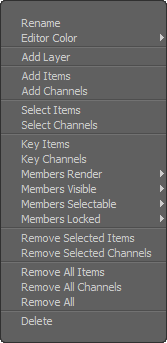 Rename: Will present the user with a popup dialog box that allows the user to rename the highlighted group.
Rename: Will present the user with a popup dialog box that allows the user to rename the highlighted group.
Editor Color: Provides users the means to colorize Group layers to help visually call out a specific group, mostly for organizational purposes.
Add Layer: Used to add additional layers for the Group, such as used in 'Actions' and 'Passes'. The 'Transfer' option will copy any scene action state values for the related element when enabled.
Add Items/Channels: Will add all the currently selected items from the item list or 3D viewport, or channels from the channels viewport to the selected Group.
Select Items/Channels: Will Items mode select all the associated items/channels within the group.
Key Items/Channels: Will add a keyframe at the current timeline position for all associated items or channels within the group.
Members Render: Sets if group members are visible in rendered images: "Default" respects item list visibility settings (or parent group settings if applicable), 'Yes' setting enables member items visibility in rendered images, while 'No' disables member items render visibility. When used in conjunction with group parenting, child group settings will override parent settings.
Members Visible: Sets if group members are visible in 3D viewports: "Default" respects item list visibility settings (or parent group settings if applicable), 'Yes' setting enables member items visibility in 3D viewports, while 'No' disables member items visibility in 3D viewports. When used in conjunction with group parenting, child group settings will override parent settings.
Members Selectable: Sets if group members are selectable in 3D viewports: "Default" respects item list settings (or parent group settings if applicable), 'Yes' setting enables member items as selectable in 3D viewports, while 'No' disables selecting of member items in 3D viewports. When used in conjunction with group parenting, child group settings will override parent settings.
Members Locked: Sets if group members are locked from property changes: "Default" respects item list settings (or parent group settings if applicable), 'Yes' setting enables member property modifications, while 'No' disables member property modifications. When used in conjunction with group parenting, child group settings will override parent settings.
Remove Selected Items: Users can select an item in the 3D viewport or Ctrl+LMB+click to select multiple items and use the 'Remove Selected Items' command to remove the selected items from the group.
Remove Selected Channels: Users can select a channel in the channel viewport or Ctrl+LMB+click to select multiple channels and use the 'Remove Selected Channels' command to remove the selected channels from the group.
Remove All Items: Will remove all items from within the group.
Remove All Channels: Will remove all channels from the group.
Remove All: Will remove everything, all items and channels from the group.
Delete: Will delete the group, removing it and its contents from the group viewport.
Items Contextual Menu--
RMB+clicking on any Item within the Group
will present the user with some Item specific options-
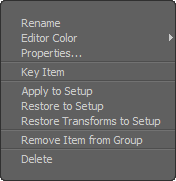 Rename: Will present the user with a popup dialog box that allows the user to rename the highlighted Item.
Rename: Will present the user with a popup dialog box that allows the user to rename the highlighted Item.
Editor Color: Provides users the means to colorize Item layers within the Group to help visually call out a specific layer (visible in the Items list as well), mostly for organizational purposes.
Properties: Opens a Properties popup for quickly editing item attributes.
Key Item: Assigns a keyframe at the current time for all animate channels associated to the item.
Apply to Setup: Takes the current channel values associated to the selected item and moves them to the Setup action state.
Restore to Setup: Replaces the current channel values associated to the selected Item with the setting from the Setup action state.
Restore Transform to Setup: Replaces current channel values with the setting from the Setup action state for only the transform (Position, Rotation, Scale) values.
Remove Item from Group: Removes the Item from the related Group, but the Item will remain in the scene.
Delete: Removes the item from the scene entirely.
Channels Contextual Menu--
RMB+clicking on any Channel within the Group
will present the user with some Channel specific options-
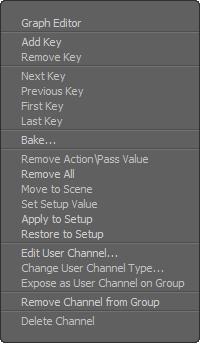 Graph Editor: Opens the selected Channel in the Graph Editor for further refinement.
Graph Editor: Opens the selected Channel in the Graph Editor for further refinement.
Add Key: Sets a keyframe at the current time with the current value.
Remove Key: Removes the keyframe at the current time.
Next/Previous/First/Last Key: Moves the timeline position to the selected location.
Bake: For a modifier driven Channel, this option will open a dialog allowing users to convert the procedural values to actual keyframes at every frame and disconnect the modifier(s). Useful when exporting animation or network rendering.
Remove Action/Pass Value: Removes the current value from the current Action/Pass.
Remove All: Removes all keyframes and returns to the default (unmodified) value.
Move to Scene: Assigns the current Channel value(s) to the Scene. Used to move a value inadvertently assigned while in a Render Pass or Actor/Action/Pose.
Set Setup Value:
Apply to Setup: Takes the current channel values associated to the selected item and moves them to the 'Setup' action state.
Restore to Setup: Replaces the current value of the selected Channel(s) and replaces it with the 'Setup' action state value.
Edit User Channel: Opens a dialogue that allows the user to modify the settings of the Users Channel, such as 'Name', 'Default Value' and the 'Minimum' and 'Maximum' values.
Change User Channel Type: Opens a dialogue to change the User Channel Type. The 'Type' determines the formatting of the resulting value, such as a Scalar, Float or Boolean.
Expose as User Channel on Group: When making Presets for surfacing, often times the author only wants to show certain channels for users to edit, instead of giving them everything. This command allows Preset creators to control which channels are exposed. By selecting specific Shader Tree item channels, the 'Expose as User Channel on Group', command will link the channels to properly defined User Channel on the Material Group item where they can be edited directly (under the 'User Channels' subtab). RMB contextual menu for the Material Group item allows authors to also 'Lock' the preset making it easier to direct the Preset end-user to the appropriate controls. See the 'Presets' page of the documentation for more information on creating presets.
Remove Channel From Group: Removes the selected Channel from the Group.
Keyframing and Selecting Group Members--
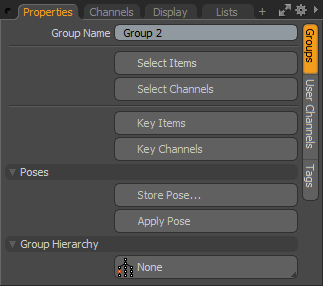 Groups can also be used to help with keyframing workflow as well as with item selections. On the Group Properties viewport there are buttons to select and key items and channels within the Group (also available via the right click context menu). When keying Group items only channels belonging to the items that are already keyed will be affected. Keying channels within a Group will add a key at the current time to each member channel, regardless of whether they have been keyed already or not. This becomes more powerful with parented Groups and the use of the Group Hierarchy buttons also displayed on the Group Properties form. By default only the contents of the currently selected groups will be keyed (or selected), but this behavior can be changed with the Hierarchy type buttons:
Groups can also be used to help with keyframing workflow as well as with item selections. On the Group Properties viewport there are buttons to select and key items and channels within the Group (also available via the right click context menu). When keying Group items only channels belonging to the items that are already keyed will be affected. Keying channels within a Group will add a key at the current time to each member channel, regardless of whether they have been keyed already or not. This becomes more powerful with parented Groups and the use of the Group Hierarchy buttons also displayed on the Group Properties form. By default only the contents of the currently selected groups will be keyed (or selected), but this behavior can be changed with the Hierarchy type buttons:
None: The default, only keys the contents of the current group(s).
Down: Keys the contents of the current groups and all child groups.
Branch: Keys the contents of the hierarchy branch that the current group resides in
Branch Related: As above but will also key the branches related to the current one, i.e. branches that share a common parent. (An example might be fingers on a hand.)
Root: Keys the contents of the entire hierarchy that the group belongs to.

When a Group contains one or more light items (directional, spot, point or any of the other light types), they can also be used to control the lights overall affect on shading on a surface by surface basis using a Shader in the shader tree with the Light Linking function. Please reference the Shader Item properties for further information.
Multiple items can act as base Prototypes for Replicators when set into a Group, allowing for greater variety in replicated objects. To use multiple mesh items as prototypes for a single replicator, first create a group that contains all the different mesh layers, once a Replicator has been created, the Group name will appear in the replicators 'Prototype' drop down list. When specified, the replicator will randomly grab objects from the group for each 'replica'. Please reference the Replicators page of the documentation for further information.


